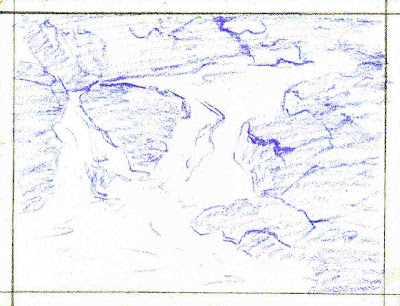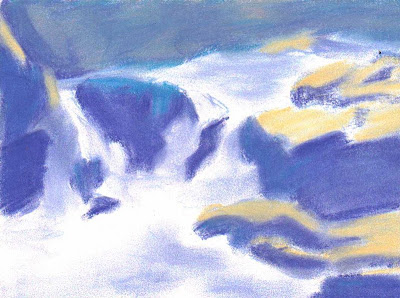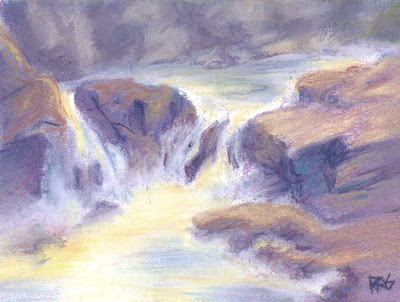
Blocking In is a technique often used in pastels. The general idea works in any medium but this article focuses on soft pastels techniques. Simplify the forms of your painting to big shapes. Ignore details and small areas unless those are in the focal area or demand reserved white.
Above is my block-in for "Lady Sunshine," a tabby cat painting. I did this one for a Pastel Spotlight challenge on http://www.wetcanvas.com that shares the same subject as this essay. DAK723 wrote a wonderful essay and demonstration of Blocking In.
Why do it? Several reasons. It lets me define light and dark masses in the painting so that when I finish it, I still have unified masses. It changes the color of the paper. I used a light gold piece of Canson Mi-Tientes on the smooth side and blocked in with Color Conte hard pastels. I worked lightly, just establishing areas of light and dark.
Most times I would smudge the block-in with my finger. This time I decided to go with sticks blending and keep the background very loose. I knew I could go back over that dark blue with a gold or reddish gold stick or play with olive greens over it to get a very natural variegated background hinting at foliage.
In a simplified version of the Colourist Method (which I will go into in later lessons) I used cool colors in the shadow areas and warm colors in the light. Most of this painting is in shadow, the cat is backlit and I really liked that dramatic lighting. The sun's coming over that bush or hedge or whatever to strike her from the upper left - mostly upper, more than left. It's on her forehead, it's all up and down the side of her we don't see and it catches the fur at the edges of her body with a delightful glow.
So I deliberately left bare paper around the block-in for the cat's shape. I put in a couple of dark marks for her features, mostly just placed her eye and a nose detail. I used a warm violet to block in her body because I wanted to stay a little close to the final color of her fur. Violet shadows are very natural, red-browns over it will give it a cool muted look.
So there's the block-in. When doing it, you can adjust the big shapes but on an animal, accurate proportion is important. Pastels are easily corrected. When it's a landscape, it's much easier to completely change the shapes to make a better composition. With a live animal those changes are limited by its anatomy. I added a bit more cat to the reference photo and was able to place her shoulder blade under the fur because I got used to sketching Ari from so many angles.
To get used to sketching cats, read my earlier article, How to Draw a Cat. This is what to do once you have a good cat sketch and want to copy and enlarge it to do a good cat painting.
You can enlarge your sketch mechanically with a copy machine or using your scanner as a copy machine. Just set it to enlarge and then move it around on the pastel paper till you have it where you want it. Rub some dry pastel on the back in a color that contrasts with the paper and works with your subject - violet sketch lines are often good for many subjects. Then trace the lines of your sketch and keep them simple.
Block in the shapes with a piece of a stick of hard pastel. I turned the pieces of my color Conte crayons on their sides to get big loose rough strokes.
Blending this block-in is a good idea on white paper. That will eliminate white specks completely. I liked the gold paper and didn't mind having a little of that show through either on the background or on the cat so I didn't blend the block-in at all. That's a decision to make per your painting.
The sketch-enlarge-block-in method will work for any subject, but cats are one of my specialties. So here she is finished - "Lady Sunshine."

What I did after the block-in was another layer just establishing basic color. I should have scanned that stage - I laid in red-brown over the cat shadows and olive green over the blue background to get it closer to true color. From there I began working over it with a variety of colors. I brought a touch of dark violet into some areas of the background, some dark brown, some yellow ochre and burnt sienna and more olive greens. I even used a few strokes of turquoise.
I decided to push the background into the distance so lightly finger-blended the background to diminish its importance.
Finger blending in pastels always dulls the colors. It'll give beautiful soft edges the more you do it and let a little bit of color go a long way. It gives beautiful gradients and shading. It will also diminish the intensity of colors a little and lose the "sparkle" that makes pastels such a rich medium.
By blending the background and using sticks to blend colors on the cat, I pulled her forward and gave her more texture. She's in focus and the background's not.
I worked over the edges of her fur with a white stick, pulling strokes out in the direction of the fur. Using three different shades of bluish gray, I started following the reference for her markings. She looks like a swirl tabby, doesn't have the little even stripes or spotted stripes of a mackerel tabby. Some stripes were more prominent than others. I also scumbled lightly over the red-brown with a light gray to lighten some areas and bring it more into a "Brown tabby" range than a ginger cat redhead color.
I didn't have a nice assortment of grayed browns in my set. The color came out richer for my using a bright red-brown followed by a little bit of gray. Why that color doesn't really show other than shifting the hue of her brown stripes but the dark gray "black" stripes show prominently is how hard I pressed.
Try this at home. Lay down an underpainting in one color, then add a related color one step over on the color wheel fairly heavily, then go over that very lightly with a near complement to mute it. Practice with the last color to see how much effect you get pressing lightly, barely touching the paper with the stick, pressing medium, pressing hard and really grinding down on the stick.
How hard you press the stick and what kind of motions you use in pastels make all the difference.
Finally I went into her light areas with white, ivory and a light yellow ochre color. I detailed her face, which is definitely the focal area. I put some whiskers in with the white stick and then applied SpectraFix fixative. I used a little too much so I wound up restating her whiskers with pastel pencils.
Final details, I used flesh pink, yellow ochre, ivory, red-brown, blue-gray and white pastel pencils to adjust small areas of color and shade between that brown area and the highlight on her face next to her nose. She doesn't actually have white fur there, it's just sun glinting on her shiny face fur.
Work with a good reference photo or work with your life sketches while your cat is actually in the room. Your colors will be a lot truer if you're looking at the real cat while you're painting.
Last tip - reserve the most detail and the most contrast for the focal area. Tat is her eye and generally her face. Her face markings show up stronger than the stripes on her neck and back. The contrast of her backlit fur is continuous but the soft edges of it down away from her face help give a fuzzy impression - as opposed to crisp strokes on her eye, the detail of her ear, her nose.
Enjoy! Definitely try this at home. You can copy my cat if you want to or you can have a really good time painting your cat from the best of your life sketches. Be sure to pay attention to the direction of the light and the shapes of shadows. If you draw the shapes of shadows accurately, you will have the shape of the form right and on top of that you'll give it good three dimensional volume. Don't let your cat sit in the pastels tray though!




